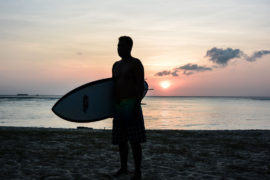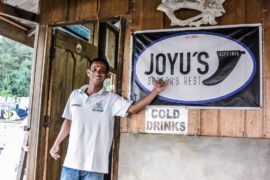Civil war, sharia, tsunami – many travelers might be put off to travel to Banda Aceh, North Sumatra. To be honest, we were also a bit unsure of what to expect. There are a lot of bias judgments spooking around. But in our experience they are all not true! We felt very welcome and safe. The waves are world class and so are the people.
In front of the surf spot in Lhoknga there is a little beach café, where Saddam and his wife Rekka make sure everybody has a wonderful time. From the first day on they welcomed us like old friend and this feeling of being home will stay with you until you leave. The little surf shack is ideal to watch the waves and enjoy a fresh and cold coconut. No wonder that all the surfers like to hang out there. What most probably don’t know: Saddam is a local surf legend! So who else would have been more suitable to talk to about surfing and its development in Aceh. During our chat, Saddam and Rekka also shared their story about how they experienced the horrifying day of the tsunami.
Saddam, where and how did you learn how to surf?
There were some people from Thailand visiting Lhoknga and they surfed. So one day they took me to Cemara beach and showed me how to surf. First, I was really scared, because nobody in my village knew how to surf back then. I was the first one – a pioneer, you know! At first I wasn’t really interested in surfing at all. But I still gave it a try – and discovered I actually had skills. I was able to stand up on my first day, so I thought: Ok I am a surfer. I just knew it.
Joyus cafe is the perfect hangout to watch the waves, can you describe the place?
In cafe Joyus we serve breakfast and drinks. Our best-seller is the cold coconut; we sell about 17-20 per day. We also rent out surfboards for 60k Rupiah per day.
From the cafe you can see three waves. A left-hander directly in front of the cafe, the famous A-frame wave, called peak, in the middle of the bay and a right-hander next to it. All waves are far out – so paddle power is vital. The left-hander can be quite fast if you take it on the peak and sometimes there are barrels. But there is also an inside, which is a bit slower and mostly also less crowded. In low tide you need to watch the reef, which is not so sharp though. With big swell you need to be careful with the current, which can be quite strong and always sucks you to the peak. The A-frame is a more advanced wave; quite powerful and fast. The coral underneath is really sharp. The right-hander is good for learning; it’s a gentle wave and there is no strong current. Although, my favorite spot is Cemara, at the river mouth bit further down the beach. I like it because it is a right-hander and I am regular. And also the paddle out is much shorter.
What do you like about surfing?
Oh surfing is just so much fun! I am excited when I catch a wave and ride it. And it makes me happy. Before the Tsunami I was riding barrels and found it very easy. But nowadays I can’t do it anymore, I think I forgot how to do it. I stopped surfing for a while from the moment on me and Rekka got married. Because in our culture, the parents of the wife expect, that the husband takes responsibility. That means he needs to have a serious job, earn good money and take care of the family. They don’t like you to hang on the beach and play in the water. So I first took a job as caddy driver in the golf club before me and Rekka started to work here in the beach cafe of Joyus.
You are quite a surf legend here and one of the first surfers. Can you tell us how you observed the development of surfing here in Lhoknga?
The first time surfers were coming to our little village was around 1980. Most of them were from Australia, but there were also some Europeans among them, from France I think. At that time there were no homestays, so they just stayed at some local people’s house. During the period of the civil war, before the tsunami in 2004, it was also not really safe for tourists to visit Aceh. So just a few people would come. But after peace was finally restored, tourism was increasing and Lhoknga became popular among surfers. Dalian Homestay was one of the first to open and today there are about ten, like Yudi’s place, Eddies Homestay, just to mention a few. Many more are in development. So I expect, that in the future more people will be coming to Aceh. This is good for business of course.
You already mentioned the Tsunami in 2004. How did you experience that disastrous event?
I was going to the beach that day because there was this strange sound in the air. Like an airplane landing. The sea looked normal. Although, the people from the other bay were shouting: “The wave is coming to the village!” But I didn’t believe it was possible. I went back to my wife’s house. All my family was already running to the mosque and I was telling Rekka: “Hurry, hurry we have to go to the mosque!” Our baby boy was one year old that time, so Rekka was packing all that baby stuff for him, as she feared he might get cold. It was really chaotic. Some people were running, some were on the motorbike, everybody was rushing to the mosque and pushing each other in panic. Suddenly everything went quiet as most people already left. The street was almost deserted so it would have been easy for us to catch up. But then I saw the wave! It was actually coming from the direction of the mosque. So I told my wife we have to go to the opposite side. I was carrying my son at my chest and was running like crazy. That was when I and Rekka got separated. The water was chasing me from behind so I took a shortcut and got to a building that looked safe. I went to the second floor just as the wave hit. The building shook dangerously as the wave hit, but luckily the water was rushing by on each side and the house didn’t collapse completely. I had to wait till all of the three waves passed. It was disastrous, the entire village was flat. I went to find my wife (which survived the wave by a miracle as well) and together we fled to the mountains, where we stayed for a couple of days with no food. When we returned to the village we learned that the rest of our family didn’t survive. I lost 16 members of my family that day. It was really, really sad. But we helped each other, because everybody lost somebody, so all we had was us and the future.
What happened after the Tsunami?
When we were in the mountains there was a phone making the round, which everyone could use to contact their family. I was calling a good friend of mine in England. I knew here since I one day saved her son from being dragged out to the sea by a strong current. We are like a family. She immediately promised me help. And few days later she arrived and she had organized about three containers of provisions donated for the people in the village. The town was a disaster, everything was destroyed or damaged and in Lohkgna everything was mostly flat, no house was standing anymore, except of the mosque. I was helping my friend in giving out the donations. And there was also a big international solidarity to help Aceh coming back on its feet. Thanks to that, we got much better infrastructure now: We have good and wide roads with no bumps, we have better and more secure houses and we have an international airport – that also helps tourism. People as well have jobs and the economy is much better than during the civil war. Also medical care and education has improved a lot. But most important of all: There is peace!
Thank you Saddam and Rekka for telling us your story. You are a wonderful and strong couple with a big heart!
We like to add a personal note: During the interview, not only Saddam and Rekka were present, but also John, Tia and some other friends of them. They all helped to remember how the day of the Tsunami looked like and what happened. It wasn’t a sad moment, even though the story is heavy burden. It was rather an exciting discussion, in which everybody was contributing some anecdotes, some of them leading to a heartfelt laugh. Unfortunately, we couldn’t follow everything they discussed, as they used to fall back in Indonesian language. But as shocking and sad the information they shared were, we could feel how strong and optimistic those people are. We have great respect for them!
Our opinion on the bias judgments surrounding Aceh - Yes, there is sharia and as in any other country you are expected to respect the local culture Women should cover themselves when walking around in town. Most of the girls would just wear a sarong when going to the beach for surfing. But we weren’t limited by the sharia in any way and the people are really friendly and welcoming. Yes, there was one of the deadliest natural disaster in recent history. But after the tsunami, peace could be restored and a civil war of thirty years was finally over. Thanks to international help Aceh was shortly back on his feet and the newly built infrastructure was better than before. Today you can expect broad and leveled roads, solid houses, good medical care and even an international airport, that is only a 30 minutes’ car drive away from the main surf village.
And on top of that: There are world-class waves and some of the nicest people we met on our trip so far. By talking to Tia, a surfer girl from Bukit Lawang, we learned also, that there exists a cultural difference between the village people of Lhokgna and the people living in the city of Aceh. While capitalism rules in the city, the people living close to the beach are much more grounded and relaxed about money. All they want is to make a living to survive and to feed their families. While the majority in the city are very conservative and traditional, the beach culture is much more open minded and blended with nature. We thought this was interesting, as it confirmed our own personal experience we made with the people from Lhokgna. And it also brings a different perspective to a law that is respected but not necessarily requested by the people.











